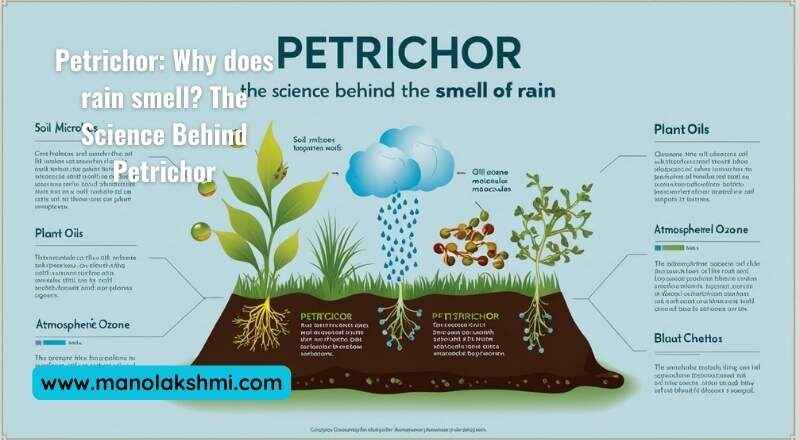Definition of Petrichor
The term “petrichor”, with its evocative and somewhat mystical quality, refers to the distinctive, earthy, and often pleasant aroma that arises when rainfall strikes dry soil or other surfaces. The distinct and often pleasant aroma of rain, particularly after a period of dryness. It is a common phenomenon linked to feelings of freshness and revitalisation. The word itself is a relatively recent addition to our lexicon, having been scientifically coined in 1964 by Australian researchers Isabel Joy Bear and Richard Thomas. The word “petrichor” originates from Greek. The term combines “petra,” meaning stone, with “ichor.” In Greek mythology, ichor is the ethereal fluid that flows in the veins of gods, as opposed to mortal blood.
This etymological origin hints at the connection between the scent and the earth itself, suggesting. A kind of essence released from the stones and soil by the touch of rain. Understanding the precise definition and origin of the term “petrichor” .Provides a crucial foundation for exploring the multifaceted phenomenon of rain smell.
The Importance of Rain Smell
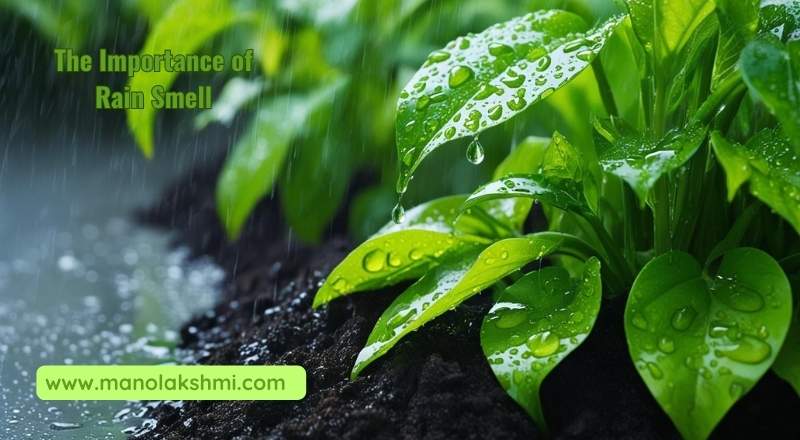
The scent of rain, particularly petrichor, holds a significant place in human experience that transcends mere olfactory perception. Across various cultures and throughout history, this unique aroma has been imbued with cultural and emotional significance. For many, the smell of approaching or falling rain evokes feelings of nostalgia, tranquillity, and a sense of connection to the natural world.
It can trigger vivid memories of past rainstorms, childhood experiences, or specific places. Beyond personal associations, petrichor often signifies relief from drought. The promise of renewed growth and fertility in the environment and a refreshing change from dry conditions. In some cultures, specific rain smells might even be associated with particular times of year or agricultural cycles, further deepening their cultural relevance.
The emotional impact of petrichor can be profound, contributing to a sense of well-being and even influencing mood. This highlights the intricate ways in which our sense of smell interacts with our memories, emotions, and cultural understanding of the environment.
The Origins of Rain’s Distinctive Aroma
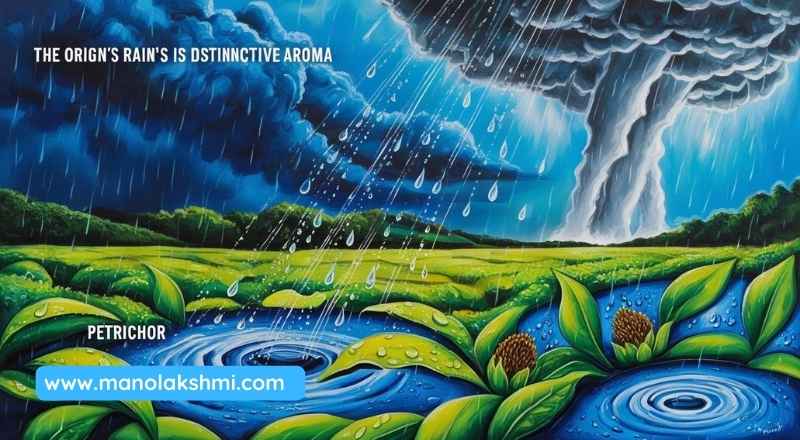
The pleasant aroma associated with rain arises from a complex interaction of factors. The chemical makeup of rainwater, biological activities within the soil, and the release of organic compounds by vegetation. Understanding this “petrichor” requires an examination of these key elements.
Rainwater Composition: A Purified Yet Reactive Medium
Fresh rainwater, in its purest form, is essentially water with dissolved atmospheric gases such as oxygen, nitrogen, and carbon dioxide. However, as it falls through the atmosphere, it can also collect trace amounts of pollutants, dust particles, and even microorganisms. The specific chemical makeup of rainwater can vary depending on geographical location and atmospheric conditions. Notably, rainwater’s relatively neutral pH and its capacity to act as a solvent allow it. To interact with various surfaces and compounds upon reaching the ground, playing a crucial role in mobilising scent-producing substances.
Soil Bacteria and Organic Matter: Earth’s Perfumers
The soil is a dynamic ecosystem inhabited by a variety of bacteria, fungi, and other microorganisms. Among these, a group of filamentous bacteria known as Actinobacteria is particularly significant in the context of rain’s smell. These bacteria decompose organic matter in the soil. A process that results in the production of a volatile organic compound called geosmin. Geosmin possesses a very distinctive earthy aroma that is detectable by the human nose at incredibly low concentrations (parts per trillion). The characteristic smell of rain arises when raindrops strike the ground, causing geosmin molecules in the soil to become airborne and detectable. The richness of organic matter in the soil directly influences the population of Actinobacteria and consequently the amount of geosmin produced.
Plant Oils and Their Contribution: Botanical Aromas Released
Many plants, particularly during dry periods, secrete oily compounds that accumulate on their surfaces. Volatile organic compounds (VOCs) frequently give various types of vegetation their distinctive aromas. When rain begins to fall, these oils are dislodged from the plant surfaces and released into the air as aerosols. The specific types of plants present in an area will determine the nature of these released oils, contributing a diverse range of aromatic notes to the overall smell of rain. For instance, the crisp, clean scent often associated with rain in forests might be partly attributed. To the release of terpenes and other fragrant compounds from trees and other foliage.
The Role of Geosmin in Petrichor

What is Geosmin?

Petrichor, the distinctive earthy smell of rain, is mainly caused by geosmin, a volatile organic compound. Geosmin, a bicyclic alcohol with the chemical formula C₁₂H₂₂O, is a key component. Its specific structure features a unique arrangement of carbon rings and a hydroxyl group. Which contributes to its distinctive aroma and its relatively low volatility. Allowing it to become airborne and detectable by our olfactory senses.
How Geosmin is Produced?

Geosmin is a metabolic byproduct synthesized by certain species of soil-dwelling bacteria, predominantly belonging to the genus Streptomyces, a type of actinobacteria. These filamentous bacteria thrive in moist soil environments and release geosmin during their life cycle and upon their death and decomposition. The production of geosmin is influenced by various environmental factors such as soil moisture content, temperature, and the availability of nutrients. When raindrops impact dry soil, trapped air containing geosmin and other aromatic compounds is aerosolised, releasing the characteristic scent of petrichor.
Human Sensitivity to Geosmin

Humans possess an exceptional sense of smell, capable of detecting geosmin at extraordinarily low concentrations, even parts per trillion. This heightened sensitivity is thought to have evolutionary roots. Some hypotheses suggest that the ability to detect geosmin may have helped early humans locate sources of clean water. As the bacteria that produce geosmin are commonly found in soil and freshwater environments. Alternatively, the association of the scent with rain might have provided a cue for anticipating changes in the environment and preparing accordingly. The pleasantness of the scent, despite its association with microbial activity, might also be linked. To positive experiences related to rain, such as the revitalisation of vegetation and the availability of fresh water.
The Influence of Ozone

The presence of a distinct and often invigorating scent associated with rainfall is a complex phenomenon influenced by various environmental factors. One significant contributor to this “smell of rain” is ozone. An allotrope of oxygen with unique chemical properties and a notable odour.
What is ozone?

Ozone (O₃) is a molecule containing three oxygen atoms, in contrast to the more common and stable diatomic oxygen (O₂) that makes up most of the air. This triatomic structure makes ozone a highly reactive gas with distinct chemical and physical properties. At ground level, it is often characterised by a pungent, sharp odour, sometimes described as metallic or similar to that of chlorine. While ozone in the stratosphere plays a crucial role in absorbing harmful ultraviolet radiation from the sun.
Its formation closer to the Earth’s surface, particularly during thunderstorms, contributes to the characteristic scent preceding or accompanying rainfall.
Ozone Formation During Storms
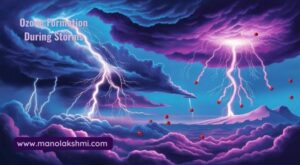
The formation of ozone during storms is primarily attributed to high-energy atmospheric events, most notably lightning. The immense electrical discharges associated with lightning break apart oxygen molecules (O₂) into individual oxygen atoms. These highly reactive single oxygen atoms can then readily combine with other diatomic oxygen molecules present in the atmosphere, resulting in the formation of ozone (O₃).
Additionally, strong updrafts and high winds associated with thunderstorms can facilitate the mixing of air layers, potentially bringing ozone formed at higher altitudes down to ground level. This process enhances the concentration of ozone near the surface, making its characteristic scent more noticeable.
Ozone’s Contribution to Rain Smell

The freshly charged and somewhat metallic scent often noticed before or during a thunderstorm is largely due to the presence of ozone. As ozone molecules are carried by downdrafts and precipitation. Their distinct odour becomes perceptible to humans, even in relatively low concentrations. This scent often precedes the actual rainfall, acting as an olfactory signal of an approaching storm. While other factors contribute to the overall “smell of rain”, the sharp, clean aroma imparted by ozone is a significant and recognisable component, particularly in environments experiencing electrical activity during storms.
How Rain Changes the Scent Landscape
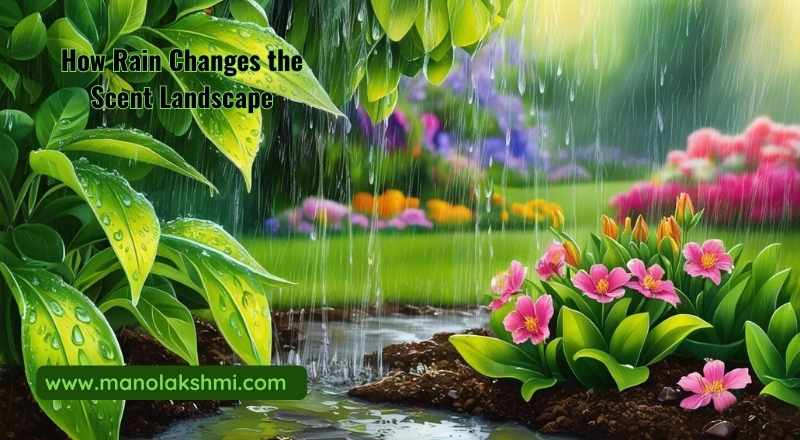
Rain profoundly alters the olfactory environment through several key mechanisms that involve interactions with the soil, vegetation, and the atmosphere itself. The characteristic smell we associate with rain is not a singular scent but rather a complex interplay of various volatile organic compounds (VOCs) released and transformed by the impact of raindrops.
Disturbance of Soil and Plant Emissions

The characteristic smell of rain largely originates from the impact of raindrops on dry soil, which triggers a series of odor-releasing events.
Aerosolization of Trapped Gases and Scents: Dry soil harbors a diverse community of microorganisms, including bacteria and fungi. Among these, Actinobacteria are particularly noteworthy for producing geosmin. A metabolic byproduct with a distinct earthy aroma that is highly detectable. By the human nose even at incredibly low concentrations (parts per trillion). During dry periods, geosmin and other volatile organic compounds produced. By these microorganisms accumulate within the soil matrix. Upon hitting the soil, raindrops trap small air pockets under their impact.
When rainwater bubbles rise and burst, they release microscopic soil particles and trapped gases, such as geosmin, into the air as an aerosol.This aerosolization is a primary mechanism by which these earthy scents are released and dispersed, making them perceptible as the precursor to the main “rain smell.”
Release of Plant-Derived Oils and Compounds: In addition to microbial byproducts, dry vegetation also contributes to the pre-rain scent profile. Many plants, especially in arid and semi-arid environments, release volatile oils and other organic compounds as a defense mechanism against heat stress and to attract pollinators. These substances tend to build up on leaf surfaces and in the nearby soil. The impact of raindrops can dislodge these aromatic molecules, releasing them into the air alongside the soil-derived scents, adding another layer of complexity to the olfactory experience.
The Impact of Intensity and Duration of Rain
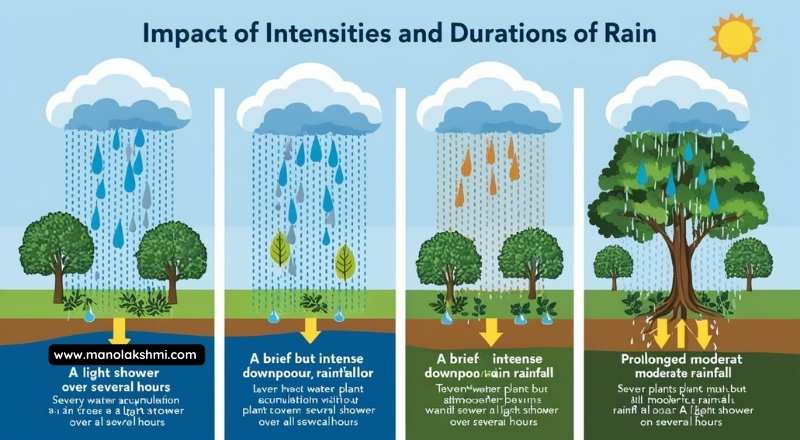
The intensity and duration of rainfall play a crucial role in shaping the strength and perceived quality of petrichor, the term coined to describe the earthy scent produced when rain falls on dry ground.
Rain Intensity and Aerosolization: Heavier rainfall with larger, more forceful raindrops tends to create a more pronounced release of aerosols from the soil. The greater impact leads to more trapped air bubbles and a more vigorous bursting action at the surface. Resulting in a higher concentration of geosmin and other VOCs being propelled into the air. Conversely, drizzle might have a gentler impact, leading to a less intense release of these aromatic compounds. However, even light rain can be sufficient to initiate the release, especially if the soil has been particularly dry for an extended period.
Duration and Saturation Effects: The duration of rainfall also influences the scent profile. Initially, the release of aerosols from dry soil dominates the smell. Once the soil is fully saturated by continued rainfall, the process of aerosolization begins to decrease. Simultaneously, the moisture begins to extract different types of volatile compounds from the soil and vegetation, potentially altering the overall scent. Prolonged rainfall can also wash away accumulated organic matter and microbial byproducts from the soil surface, potentially reducing the intensity of petrichor over time.
Seasonal Variations in Petrichor
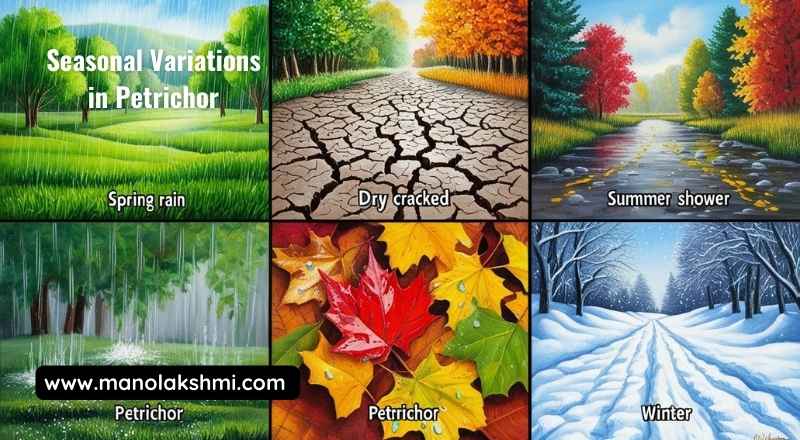
The aroma of rainfall varies considerably with the time of year and the surrounding environment.
Influence of Vegetation Cycles: Seasonal changes in vegetation have a significant impact on the volatile organic compounds present in the environment. During periods of active plant growth, the release of plant-derived terpenes, esters, and aldehydes can contribute distinct notes to the rain’s scent. For instance, the fragrance of rain in a pine forest during the warmer months might carry resinous and woody undertones due to the release of terpenes from the pine needles. In contrast, the scent of rain in a grassland might differ depending on whether the grasses are dry and releasing their own set of compounds or are actively growing and emitting fresh, green aromas.
 Microbial Activity and Soil Conditions: Seasonal temperature and moisture fluctuations directly affect the activity of soil microorganisms, including the Actinobacteria responsible for geosmin production. Warmer, drier periods often lead to an accumulation of geosmin in the soil as microbial activity might slow down but not cease entirely, and the compound is not readily dispersed by moisture.
Microbial Activity and Soil Conditions: Seasonal temperature and moisture fluctuations directly affect the activity of soil microorganisms, including the Actinobacteria responsible for geosmin production. Warmer, drier periods often lead to an accumulation of geosmin in the soil as microbial activity might slow down but not cease entirely, and the compound is not readily dispersed by moisture.
When the first rains arrive after such a period, the concentration of geosmin released can be particularly high, resulting in a strong earthy scent. Conversely, during colder or consistently wet seasons, the microbial communities and the types of volatile compounds they produce might shift, leading to subtle variations in the petrichor.
Ecological Context: The wider environment influences this phenomenon. The scent of rain in a coastal region might be influenced by the presence of marine aerosols and the specific types of vegetation adapted to saline conditions. Similarly, the petrichor in a forest ecosystem with a rich layer of decomposing organic matter might have a more complex and musky character compared to that of a drier, more mineral-rich environment.
Measurement: Understanding Rain Gauges and Their Importance
Psychological and Emotional Responses to the Smell of Rain

The distinctive scent of rain, often referred to as petrichor, extends beyond a mere olfactory experience, delving into the realms of human psychology and emotion. This section explores the intricate ways in which this natural aroma interacts with our minds, triggering memories, influencing our moods, and holding diverse cultural significance.
The Profound Connection Between Smell and Memory

The sense of smell possesses a unique and powerful link to memory, often bypassing the cognitive processing stages associated with other senses. Consequently, the scent of petrichor frequently acts as a potent trigger for vivid memories and feelings of nostalgia.
This phenomenon, known as the Proust effect, occurs because olfactory information travels directly. To the amygdala (the brain’s emotional center) and the hippocampus (involved in memory formation). Therefore, a particular rain shower might unexpectedly transport an individual back to a cherished childhood moment, a significant life event that occurred during a downpour, or simply a feeling of comfort and security associated with rainy days.
The specific compounds contributing to petrichor can become deeply encoded with these experiences, making the scent a powerful key to unlocking forgotten moments and associated emotions. Further research explores the specific volatile organic compounds within petrichor that are most effective in eliciting these nostalgic responses and the neurological pathways involved in this olfactory-memory connection.
The Effect of Rain Smell on Mood and Well-being
Beyond triggering past memories, the smell of rain has been linked to tangible effects on current mood and overall well-being. Several studies have investigated the psychological impact of exposure to natural scents, including those associated with rain.
Rain-related airborne molecules may induce calm, relaxation, and joy due to learned associations and potential brain chemistry effects. Geosmin, a component of petrichor, might have a soothing effect. Future studies could identify specific mood-enhancing chemicals and explore therapeutic uses for rain-like scents in stress and anxiety management. Individual scent sensitivity and personal experiences also merit further research.
The Cultural Significance and Interpretation of Rain’s Smell

The scent of rain is not merely a universal sensory experience. But also one that is imbued with cultural meaning and value across different societies. Throughout history and in various parts of the world. Rain has held immense significance, often associated with fertility, renewal, and sustenance.
Consequently, the unique aroma that accompanies. Some cultures may have specific terms or expressions to describe the smell of rain, highlighting its importance in their sensory landscape. Traditional ecological knowledge within certain communities might even link specific rain smells. To particular types of rain or the health of the environment.
Exploring these diverse cultural perspectives reveals how the human experience of petrichor is shaped not only. By biological and psychological factors but also by learned associations, societal values, and the rich tapestry of human culture. Anthropological and ethnobotanical studies can provide valuable insights into these varied interpretations and the role of rain’s scent in cultural practices and beliefs.
Environmental Impact of Petrichor
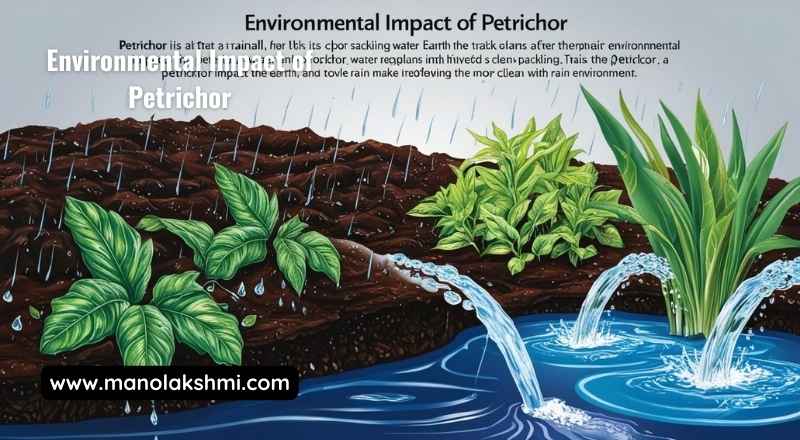
Petrichor’s influence transcends simple sensory perception, impacting ecological and agricultural processes in subtle yet meaningful ways. Understanding its environmental impact can offer valuable insights. Into the intricate relationships within ecosystems and the signals that govern natural behaviors.
Role in Ecosystems

The distinct scent of rain, particularly petrichor, can influence the behavior of various animal species. Certain animals might associate the smell with the onset of rain. Which can signify changes in humidity, temperature, and the availability of water sources. This olfactory cue could trigger specific behaviors such as seeking shelter, foraging for food stimulated by the moist conditions.
Further research is needed to fully understand the extent and specificity of these interactions. But it is plausible that petrichor acts as an environmental signal that contributes to the complex dynamics of different ecosystems.
For example, certain insects might be attracted to the moist earth after rainfall, providing a food source for other animals. Similarly, the change in air composition and ground moisture could affect. The dispersal of fungal spores or the activity of soil microorganisms.
Importance for Agriculture and Crop Growth

For agricultural practices, the scent of approaching rain can serve as a natural indicator of favorable conditions for plant growth.
Petrichor, the scent of rain, may subtly signal farmers to prepare soil, sow seeds, or conserve water. Rainfall, often with this smell, is vital for replenishing soil moisture.
Which is essential for seed germination, plant growth, and overall crop yield. The connection between the anticipation of rain (signaled partly by petrichor) and successful agricultural outcomes highlights. The importance of understanding these natural cues in the context of food production and resource management.
Effects of Pollution on Petrichor

Environmental pollution has the potential to alter various aspects of the natural environment, and the delicate chemical processes. That contribute to the scent of petrichor may also be susceptible to these effects. Air pollutants, such as volatile organic compounds (VOCs) and particulate matter, could interact with the oils released by plants. (or) The actinobacteria in the soil, potentially changing the composition and intensity of the resulting scent. Soil contamination may disrupt the microbial ecosystems that generate geosmin, a crucial element contributing to petrichor.
Changes in the characteristic scent of rain due to pollution might have unforeseen consequences, potentially disrupting. The ecological signals that certain organisms rely on or altering the traditional understanding of weather patterns in agricultural communities. Understanding how various pollutants influence the creation and human detection of petrichor is essential for evaluating. The wider environmental effects of human actions.
Water Cycle Explained: The Lifeblood of Our Planet
Conclusion
Summary of Petrichor and Its Components
The characteristic smell of rain, called petrichor, results from volatile organic compounds released by dry soil and rocks. Actinobacteria in the soil produce geosmin, a potent organic compound detectable. Even in very small amounts, significantly contributing to this distinctive aroma.
Additionally, oils secreted by certain plants accumulate on surfaces during dry spells. The characteristic smell of rain arises when raindrops hit the ground, especially dry soil or rocks. This impact causes air bubbles to become trapped. These bubbles ascend and rupture, releasing aerosols containing geosmin and oils from plants into the air.
Petrichor’s intensity and distinct aroma depend on the duration of the preceding dry spell, soil and vegetation types, and rainfall intensity. This familiar scent arises from intricate biological and physical interactions.
The Continued Fascination with Rain and Its Smell
The smell of rain, known as petrichor, has long been culturally significant, evoking feelings of freshness and renewal. Rain after dry periods is often celebrated as a sign of relief and growth. This scent can also trigger memories and connect people to places. Ecologically, the released compounds might attract organisms to moist areas. The enduring fascination with petrichor highlights our connection to nature and the power of sensory experiences.
Call to Action
Cultivate awareness of the natural world and engage with sensory experiences. Take a moment during the next rainfall to step outside and consciously appreciate the subtle yet distinct aroma of petrichor. Observe the changing environment, listen to the sounds of rain, and fully engage with the current moment.
By closely observing natural phenomena, we enhance our comprehension of Earth’s complex systems and appreciate its beauty. Engaging our senses to connect with nature reveals the significant impact of even simple scents like rain on our lives.
